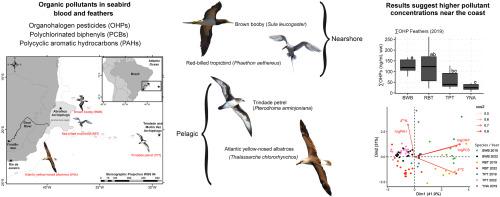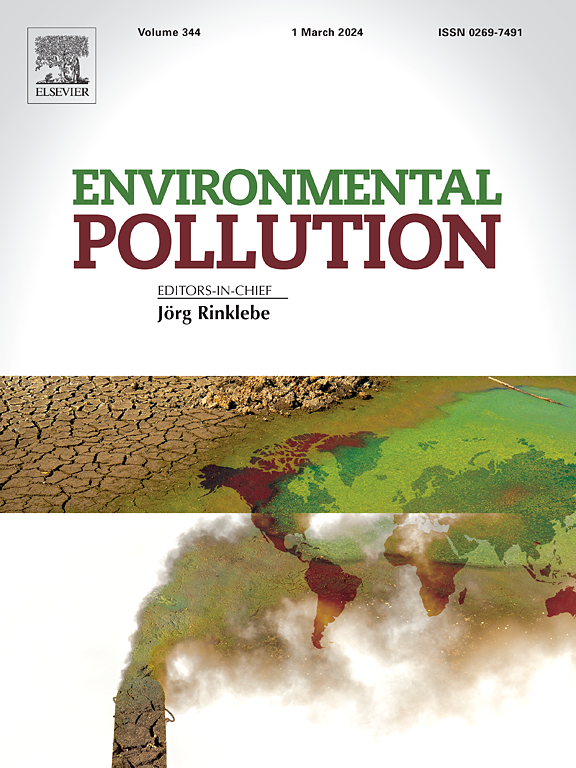Concentrations of organic pollutants in seabirds from the tropical southwestern Atlantic Ocean are explained by differences in foraging ecology
IF 7.6
2区 环境科学与生态学
Q1 ENVIRONMENTAL SCIENCES
引用次数: 0
Abstract
Persistent organic pollutants are a potential threat for marine vertebrates in both coastal and offshore areas. In this study, organic pollutants were evaluated in the blood and feathers of four seabird species that forage in the tropical southwestern Atlantic Ocean. Red-billed tropicbirds (Phaethon aethereus) and brown boobies (Sula leucogaster) were sampled in the Abrolhos Archipelago, 70 km from the coast, and used as proxies of nearshore contamination. The Trindade petrel (Pterodroma arminjoniana) was sampled on Trindade Island, 1200 km offshore, and the Atlantic yellow-nosed albatross (Thalassarche chlororhynchos) was sampled at sea, both used as proxies of pelagic contamination. Concentrations of organohalogen pesticides (∑OHP) and polychlorinated biphenyls (∑PCB) were generally higher in the booby, the most nearshore forager, followed by the tropicbird, petrel and the albatross. Carbon isotope values (δ13C) were positively associated with ∑OHP and ∑PCB in the blood of seabirds and explained 28.6% of the variation in pollutant data, suggesting higher concentrations of pollutants in the nearshore marine habitats, where δ13C is generally higher. Nitrogen isotope values (δ15N) also had a positive influence over pollutant concentrations and explained 13% of pollutant data, suggesting an influence of trophic level. Variations in polycyclic aromatic hydrocarbons (∑PAH) concentrations among species, and relationships with isotopic values were less clear. Furthermore, the concentrations of organic pollutants were substantially higher in 2019 than 2022, which suggests greater environmental pollution in 2019 that could be related to urban and agricultural sources. Results demonstrate relationships between seabird ecology and organic pollutants in the tropical marine environment and highlight the importance of assessing multiple species in monitoring pollutant concentrations in wildlife.

求助全文
约1分钟内获得全文
求助全文
来源期刊

Environmental Pollution
环境科学-环境科学
CiteScore
16.00
自引率
6.70%
发文量
2082
审稿时长
2.9 months
期刊介绍:
Environmental Pollution is an international peer-reviewed journal that publishes high-quality research papers and review articles covering all aspects of environmental pollution and its impacts on ecosystems and human health.
Subject areas include, but are not limited to:
• Sources and occurrences of pollutants that are clearly defined and measured in environmental compartments, food and food-related items, and human bodies;
• Interlinks between contaminant exposure and biological, ecological, and human health effects, including those of climate change;
• Contaminants of emerging concerns (including but not limited to antibiotic resistant microorganisms or genes, microplastics/nanoplastics, electronic wastes, light, and noise) and/or their biological, ecological, or human health effects;
• Laboratory and field studies on the remediation/mitigation of environmental pollution via new techniques and with clear links to biological, ecological, or human health effects;
• Modeling of pollution processes, patterns, or trends that is of clear environmental and/or human health interest;
• New techniques that measure and examine environmental occurrences, transport, behavior, and effects of pollutants within the environment or the laboratory, provided that they can be clearly used to address problems within regional or global environmental compartments.
 求助内容:
求助内容: 应助结果提醒方式:
应助结果提醒方式:


